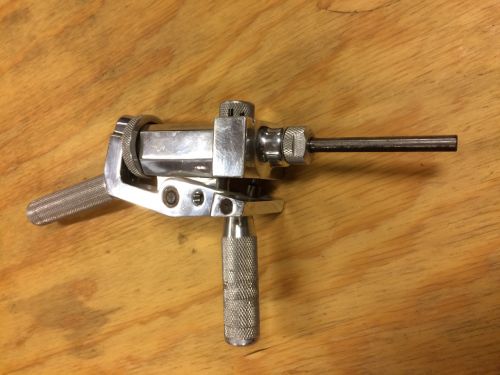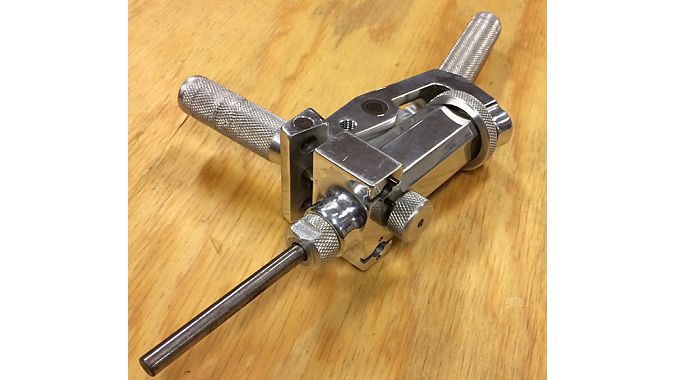FORT COLLINS, Colo. (BRAIN) — The tool is heavy in your hand, with parts polished as smooth as an infant's spoon and other areas knurled as rough as a carpenter's rasp. It resembles a component of an expensive European espresso machine, with an array of baffling knobs, screws, and handles.
Some say it resembles a tattoo gun.
What it doesn’t resemble — for most people — is anything they've seen in a bike factory or on a shop work bench. Nevertheless, for years George Parry has saved it from the recycling bin. Parry, the engineering and production manager at Niner Bikes, has kept it around the Niner offices in Fort Collins, both to entertain and puzzle visitors and out of respect for its quality and what it represents.
“It’s just so well made, and obviously a lot of thought and engineering went into it,” said Parry. “As an engineer you appreciate that.”
Until this week, Parry had no idea of the tool’s purpose. But he was familiar with its recent history, as far back as Schwinn’s post-bankruptcy move from Chicago to Colorado in the mid-1990s. That was just the tool's first cross-country relocation.
Over the following decade and a half, the tool, along with other equipment from Schwinn’s legendary Chicago facility, would move from Boulder, Colorado, to Olney, Illinois, and then back to Longmont, Colorado, as the Schwinn brand was moved, went bankrupt again, was split up, re-bundled and moved once more.
Parry had started with GT Bicycles in 1996 and went to work for Schwinn in Colorado when GT and Schwinn were under the same corporate umbrella there. He ran the company’s test lab in Boulder, and later helped set up the lab, with much of the same equipment, in Olney, in a former Roadmaster bicycle factory. Then the stuff came back to Colorado, where he used the equipment at a lab in Longmont.
The mystery tool came along for a ride on all of the moves, as far as Parry knows. “I don’t remember exactly when I first saw it, but I’m sure it was kicking around at the Boulder test area," he said.
Left behind
Over the years, some of the Chicago equipment got separated and left behind. There are still several bike companies in Colorado with tooling bearing a Schwinn label. Stages Cycling, the Boulder power meter maker whose founders include several Schwinn/Scott Sports Group veterans, has a few Schwinn machines, for example.
Schwinn’s owner since 2004, Dorel Industries, moved the brand’s Colorado employees to Connecticut and moved the Colorado test lab equipment to the Cannondale lab in Pennsylvania. Parry declined to leave Colorado and instead took a job with Niner in Fort Collins. At the same time, Niner bought some of the Schwinn machines that Dorel didn’t want to move to Pennsylvania.
Like Parry, the mystery tool stayed in Colorado.
“It’s been here since we bought the stuff in 2010. I kept it in the office and would take it out occasionally to show to people,” Parry said.
Company to watch
On Monday evening, Niner Bikes was being honored as one of 50 companies to watch in Colorado. After speeches from Fort Collins’ mayor and a representative from the governor’s office, a few cycling journalists and friends took a tour of the Niner building.
In an engineering room, Parry showed us a 3D-printed frame prototype; next to it was the intriguing little tool. Parry challenged us to guess its purpose, but no one came up with anything plausible
BRAIN took some photos and posted them on our Facebook page the next day, asking our social media followers to try to identify its purpose.
In less than an hour, Michael Fritz left a comment and identified the tool that had baffled bike engineers and others for several decades.
‘Born at Schwinn’
“I was cruising Facebook this morning and came across that picture and said, ‘holy shit, I know that tool!’" Fritz told BRAIN on Tuesday.
Fritz worked for Schwinn from 1973 until 1990. Although he worked for the company for just 17 of his 64 years, Fritz is a Schwinn lifer.
That’s because Michael Fritz’s father, Al Fritz, who passed away last year, was a key Schwinn executive for many years and is legendary as the inventor of the Schwinn Sting-Ray. So Mike Fritz grew up as part of the Schwinn company family.
“I was born at Schwinn,” he likes to say.
In the early part of his career at Schwinn, Mike Fritz, who had an undergraduate degree in engineering with a minor in metallurgy, was involved in making tooling to mass produce various Schwinn products. He was also involved in safety and testing.
He initially worked under longtime Schwinn engineer Gene Heitlinger, who he described as “a brilliant renaissance man, an artist, a musician, and an engineer. He was a little short guy with white goatee.”
In the early 1970s, the newly formed U.S. Consumer Product Safety Commission had floated a draft bicycle safety standard that was of great concern to the bike industry, Schwinn included. One draft regulation included a rule against sharp edges on a bike.
“Well, ‘sharp edge’ is a vague term, so we had to come up with a way to measure that,” remembered Fritz. “At first we learned that pig skin was similar to human skin, but we came to the conclusion that we couldn’t come up with a consistent test with pig skin. Then Gene did some research and discovered that 3M made a material that simulated human skin.”
With this 3M material in mind, Heitlinger and Fritz began developing a tool to test the sharpness of a product edge. After several prototypes — all made in-house in Schwinn’s fabrication facility in Chicago — they came up with the tool that landed on a table in Fort Collins at a party four decades later.
The tool includes a shaft that was wrapped with the 3M tape. A spring would press the tape against the product edge that was being tested, then it would rotate the tape-wrapped shaft exactly one rotation.
“If the edge was sharp enough to cut the tape through to the metal cylinder, the edge was judged to be too sharp and thus in violation of the CPSC regulation,” Fritz said.
The tool was typically used to check the sharpness of stamped bike parts, including chain guards and reflector brackets, he said.
However, the sharpness rule was eventually rewritten in a way that made the tool unnecessary and the tool was retired. Other than the earlier prototypes, only one was ever made.
“No doubt it was in the test lab in a cabinet someplace, and it got shipped to Colorado when the company moved, and someone wound up with it,” Fritz said.
"It’s certainly conceivable that nobody had a clue what it was for, but I remember it like it was yesterday."
‘Nothing half-assed’
For Fritz, the tool represents a time when the U.S. bike industry, Schwinn in particular — and let's just say U.S. manufacturing, in a larger sense — was in its heyday.
“That tool was all done in-house, and it was done well. That was in the days when Schwinn was very vertically integrated. We made a lot of our own parts; we made our own tools. And we didn’t do anything half-assed. If Schwinn was going to do something, we were going to do it right. This was in the old days before most bicycle engineering, development and production was shipped to Asia.”
Fritz, now a consultant to the e-bike industry, said he would like to obtain the tool from Niner, as a souvenir of his early career.
On Wednesday, Niner’s Parry said he would make arrangements for the tool's next journey, to Fritz's home in Newbury Park, California.
“We’ll get it back to him for sure,” he said. “I didn’t expect someone to come out of the woodwork and identify it, but it’s very interesting to finally learn what it’s for.”
“I am a little sad, though,” Parry said. “We’re losing a great conversation piece.”






